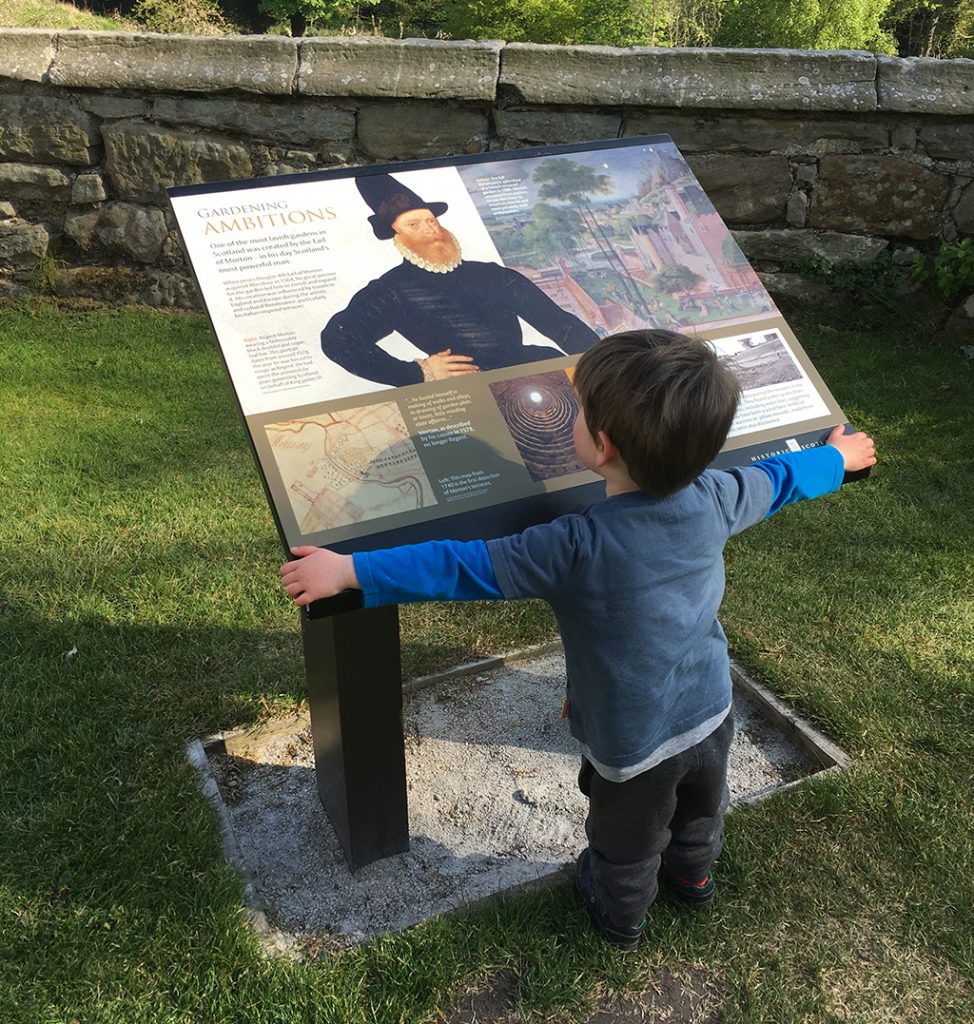18 May 2017 was International Museum Day, and the theme was “Museums and contested histories: Saying the unspeakable in museums.” This got us thinking about the aspects of history that are traditionally overlooked or forgotten. One of these is mental health, so here we look at historical attitudes to mental illness.
A Tale of Two Sisters
Last year, I was lucky enough to work on new interpretation panels for Aberdour Castle in Fife. I worked with several historians who dug up some fascinating stories. One account stood out as being particularly poignant – the story of two sisters who, for many reasons, became trapped in a gilded cage.

My son Will takes the measure of Regent Morton at Aberdour Castle.
Elizabeth and Margaret Douglas were granddaughters of King James IV, and therefore highly eligible for marriage. They both married men who, at different times, became regent of Scotland – men who ruled the country when the monarchs were too young to do so. The women may therefore have expected to lead a highly public life, but instead they are almost entirely invisible to historians. This is because the sisters were affected by mental illness.
Today there seems to be a growing awareness of the impact of mental illnesses on individuals and their families. Amy Blakeway, a historian I worked with on the project, explained:
“in the 1500s, there is little evidence which shows how people with mental illness were treated, but it is likely that the shame associated with these illnesses meant families tried to keep it a secret. Terms, which may sound cruel to our ears, such as ‘idiot’, ‘lunatick’ or ‘furious’, indicate a contemporary lack of understanding of mental ill health and the anxiety it provoked.”
Margaret Douglas

Margaret spent much of her time at Kinneil House, near Bo’ness.
James Hamilton, 2nd Earl of Arran became regent for Mary Queen of Scots. His marriage to Margaret in 1532 benefitted both families and Margaret received Kinneil House, near Bo’ness, as part of the marriage settlement. Although she had at least seven children, a success in dynastic terms, the marriage did not run smoothly. At one time, they temporarily separated when Arran tried to end the marriage. Although they reconciled, Margaret spent much of her time at Kinneil, away from the public gaze.
Elizabeth Douglas
James Douglas, 4th Earl of Morton, who has the reputation as being one of the most ruthless and politically calculating men in Scotland, came to power during James VI’s minority. Almost 30 years before his ascendency, in 1543, Morton married Elizabeth. Through the marriage he inherited his earldom and Aberdour Castle, where he installed beautiful Renaissance style gardens, and here he spent much of his time entertaining friends and holding meetings with ambassadors. Elizabeth, however, may never have visited Aberdour. She lived much of her adult life at Tantallon Castle in East Lothian, away from political life, just like her sister.

James Douglas installed Renaissance style gardens at Aberdour – but did his wife ever see them?
A rare record of Elizabeth described how she:
“bare to him [Morton] divers children (ten as is reported) but none of them lived long, but died all young, ere they came to perfect age. She herself became distracted of her wits, and would not company with her husband. […] She was kept and entertained by him as became her place, and had her residence at Tantallon, but he being deprived of her Company, loosed the rains to others.”
What happened next?
Many questions remain over the lives of these sisters, and how their illnesses changed their role within high-profile marriages. Margaret died in 1579. This was not long after her family was accused of treason (by none other than her brother-in-law Regent Morton), and her son James was described as “an idiot, or altogidder furious”, perhaps suggesting the illness was hereditary. Morton was eventually executed for treason and Elizabeth, denounced as an “idiot and prodigal”, was forbidden to manage her own affairs. Little is known of the rest of her life.
When I finished writing the new interpretation for Aberdour, this story stayed with me and I think of Elizabeth and her sister when I visit the castle. The fact that we can now tell a little of their story seems fitting – we can bring them out of the shadows, even in a small way.
Acknowledgement: Thank you to Dr Amy Blakeway, lecturer at the University of Kent and author of Regency in Sixteenth-Century Scotland.

